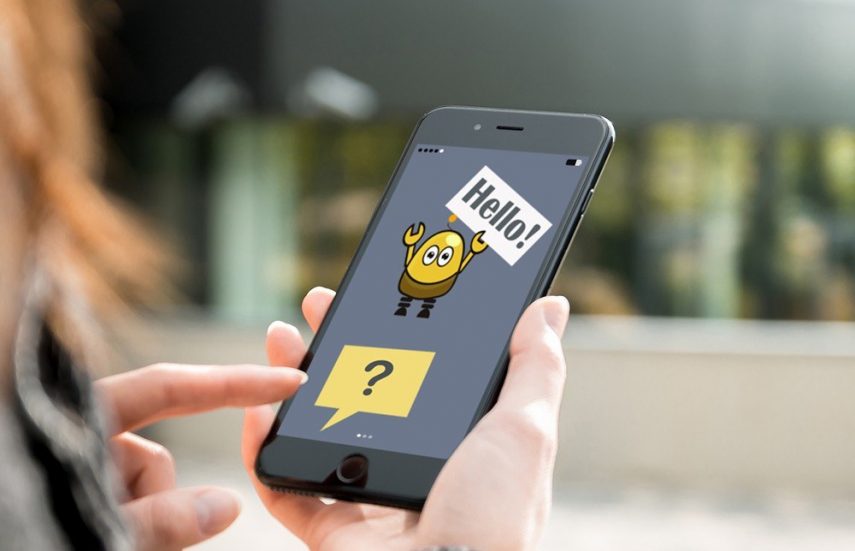Chatbot Development
What is chatbot technology? Short for chat robot, a computer program that simulates human conversation, or chat, through artificial intelligence. Typically, a chat bot will communicate with a real person, but applications are being developed in which two chat bots can communicate with each other. A chat bot is also called a chatterbot

Chatbots are a huge trend, there’s no doubt about it. Big name brands are jumping at the opportunity to meet their customers where they’re already spending time — in messaging apps. That’s why we are seeing a massive number of bots appearing in various different industries, from e-commerce and fashion to more conservative sectors like banking.
Generally speaking a chat bot is any software that performs an automated task, however we are interested in the class of bots that live online in chat platforms or on social media called chatbots. In this context there are many possible definitions and some confusion about what a bot is. This is partly because there are so many varied use cases for bots and these influence what people perceive a chatbot to be.
Because of the three major trends that are creating the perfect storm for the rise of chatbots:
- the ever-present app fatigue
- the explosion of messaging apps, and
- the increased commoditization of AI algorithms.
Answering Questions. Your attendees will have questions, a lot of them. They’ll want to know things like, what’s the wifi password, how to get to the venue, when a certain talk begins, and more. Unlike traditional channels such as email and phone, chatbot is a much more scalable solution — it can provide immediate answers to hundreds of attendees at once.
Chatbots we interact with today may be built to do simple things, but as bot makers start to leverage advanced machine learning technologies, bots will become more intelligent and capable of interacting with users in more contextually relevant ways.
- Providing on-demand agenda.
An event bot can deliver all the agenda info your participants need, including sessions schedule, talk abstracts, and speaker profiles directly from their favorite messaging app.
- Delivering notifications
You can use a chatbot to inform attendees about sudden changes in schedule, speaker cancellations, or room switches. It’s also great for sending scheduled, personal reminders e.g. when the session an attendee favorited is starting.
- Gathering attendee feedback
Smart event chatbots typically have different attendee feedback functionalities, such as Live Polls and ratings. Your chatbot can ask attendees to rate sessions and speakers, or launch polls on relevant topics.
Three types of Chatbots
To understand the nature of chatbot conversations it is important to understand that there are three types of chatbots.
1. Scripted chatbots
Conversations with this type of chatbot can only follow predetermined paths. At each step in the conversation the user will need to pick from explicit options to determine the next step in the conversation. How the options are presented to the user at each step in the conversation, i.e. whether they need a text, voice or touch response will depend on the features of the chat platform and how the bot is programmed that the user is on and the design of the bot.
2. Intelligent chatbots
Artificial intelligence allows them to be more flexible in terms of the user input they can accept. They can accept free form input in the form of text or voice statements (but of course they are not limited to other forms of input if that makes sense). AI also allows them to improve the more that they are used. It should be noted however that although AI works very well in very limited knowledge domains, or for one off instructions, the actual intelligence of the bot is limited. It is extremely difficult to get a bot to “understand” context or ambiguity or to have a useful memory that influences the conversation.
3. Application chatbots
As mentioned, both scripted and intelligent chatbots can have graphical user interfaces. Application bots is therefore not a separate category of bots per say. The fact that the bots can be interacted with using a graphical user interface is an important concept for chatbot developers. If a user can do the job they need to do more efficiently via a graphical interface then the bot needs to show a graphical interface at that point in the conversation.
What can AI chatbots do for your customer service?
More and more businesses are choosing AI chatbots as part of their customer service team. There are several reasons for that. Chatbots can answer customers’ inquiries cheaply, quickly, in real-time. Another reason is the ease of installation of such chatbot: once you have a fine live chat app, it takes a couple of minutes to integrate a chatbot with it.
Here are the top advantages of using AI chatbots for customer service.
- Rapid answers
Chatbots don’t need to sleep. They can immediately tackle issues no matter if it’s 4 am or 9 pm. This is crucial for companies targeting millennials (who can be impatient). This allows you to improve customer support and the customer experience.
- Less groundwork
Chatbots can handle a high volume of requests with similar responses. This makes them perfect for dealing with frequently asked questions. Besides, chatbots don’t need time to search for answers as human agents do. This helps reduce service time as much as fivefold and operating costs by as much as 66 percent. Chatbots can direct customers to a live agent if the AI can’t settle the matter. This lets human agents focus their efforts on the heavy lifting. AI chatbots also increase employee productivity.
- Fewer errors
AI chatbots make fewer errors while answering customer inquiries than human agents do. Why? Because their cognitive technology interprets customers’ responses and provides accurate, automated answers. Chatbots have a lot of memory. This reduces the chances of misinterpreting a query or offering an incorrect solution.
- Increased customer engagement
Chatbots can strike up a conversation with any customer about any issue at any time of day. They engage in friendly interactions with customers. Besides, virtual assistants only give a bit of information at a time. This way they don’t tire customers with irrelevant and unnecessary information. Chatbots can maintain conversations and keep customers on your website longer.
- Proactive customer interactions
Generally, companies engage in passive customer interactions. That is, they only respond to inquiries but don’t start chats. AI bots can begin the conversation and inform customers about sales and promotions. Moreover, virtual assistants can offer product pages, images, blog entries, and video tutorials. Suppose a customer finds a nice pair of jeans on your website. In this case, a chatbot can send them a link to a page with T-shirts that go well with them.
- Handling simple transactions
Chatbots can perform a range of simple transactions. Telegram bots let users transfer money, buy train tickets, book hotel rooms, and more. AI chatbots are especially sought-after in the retail industry. Chatbots are especially effective where you can predict questions and script answers.
Facebook Messenger is one of the most popular applications in the world. Now over 1.2 billion people actively use Messenger every month.
Messenger chatbots from different branches that are already successful.
- Entertainment
Is a time when people can relax. When they can have some fun and forget about routine for a while. But, people do not often have time for some extra activities in today’s world. Searching for interesting content makes you tired and bored, even when you are visiting a news website. So people have found another way to have fun. This “way” is their smartphones. People use FB Messenger via phone every day. That’s why Messenger chatbot games were developed.
One of the most spread chatbot games in Facebook Messenger is MojiHunt. It was followed by more than 20 000 users.
Construction Industry
Together, the systems can issue the second bill of lading, give the customer’s financial position, negotiate online, send expiration notices and billing alerts. All this automatically. All the customer has to do is request through the chatbot. Push, in addition to being trained in a variety of client approaches, is enabled to acknowledge their intentions, even when it isn’t being explicit or clear. The most interesting is that over time, it manages to stay smarter and meet even more needs.
Some benefits of ChatBots in the Construction Site;
- Real time info about machinery and team performance
- Construction site activity related photo and progress sharing
- Tracking real-time activity progress
- Easy access to location related drawings and info.
- Notification for urgent needs and requirements
- Easy sharing of contractor, warehouse and material info.
- Publishing daily progress report easily and accurate.
- Notification to the site engineers
- Tracking real-time activity progress
- Just in time procurement and contractor management
- Fast update in construction planning tools
- Easy multi disciplinary coordination
- Easy access to construction documents and drawings.
- Hotels and Restaurants
Personalizing the room according to guest needs can be done through chatbots. By simply answering few questions, guest can book the room according to their own preference during the check-in. Similarly, if the guest wants to book a ride, order food, get room services or other hotel services, chatbots are there to serve them.
- News
First through weblogs, then eventually through social networks such as Facebook and Twitter, where a huge number of people start to spend a lot of time. And after that chatbots moved in. Famous media brands have launched their chatbots. It’s very perspective. CNN chatbot is one of the most popular chatbots. The future of chatbots in news and media is bright as it allows the user to read the topic that they love. The data is collected through past search behavior of users allowing them to view content that is relevant to their interest.
- Health
Health is one the most important things in our lives. You can be a successful person but without health, it makes no sense. Today people are very busy and have no time to visit a doctor to check their symptoms. Health Tap - is a chatbot that you can tell certain symptoms and it will give your doctor’s advice.
- Banking
Traditional financial services can be tough for customers to navigate. Many consumers have trouble saving money, and others experience confusion over their bank’s policies or services available to them. This has caused many to flock to new fintech solutions like Mint or Simple. Banking is among industries using chatbots for a much-needed customer service overhaul. Chatbots make it easier than ever for customers to get in touch with their banks and put their policies to good use.
Recently, new tools designed to simplify the interaction between humans and computers have hit the market: Chatbots or Virtual Assistants. In banking, chatbots and virtual assistants are some of the industry’s newest tools designed to simplify the interaction between humans and computers.
For example, you write “I have a sore throat and headache” and it responds you “Sounds like you are coming down with a cold, drink plenty of fluids and rest”.
- Customer service
Customer service is very significant. Companies always have problems with customer service. In general, clients wait for a response for too long or even don’t get one. This leads to negative reviews and dissatisfied customers. Incredible customer service of popular brands like Adidas or Nike. These brands really have their chatbots which facilitate customer service. They are very fashionable trademarks that have a huge number of consumers.
Real Estate
Chatbots can’t replace that client-agent relationship, but they can replace agents in answering general real estate questions. Holmes - one of the first chatbots in real estate. It uses artificial intelligence to detect buyers’ and sellers’ questions and answer them in real-time in messenger.
To be successful, a chatbot solution should be able to effectively perform both of these tasks. Human support plays a key role here: Regardless of the kind of approach and the platform, human intervention is crucial in configuring, training and optimizing the chatbot system
Products Features
We are specialists in the area of online and offline software development. All our services are intended to solve new and old problems to deliver the best technology at your doorstep.
Service Specification
Technology changes fast. We have the ability to develop software that can be tuned to your desire at any time. We make technology learn your ways


